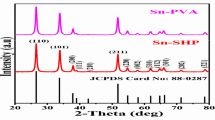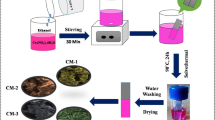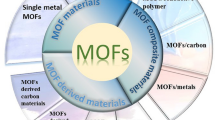Abstract
Conducting polymers have recently attracted considerable attention for supercapacitor applications. This study demonstrates that the combination of poly ethylene oxide (PEO) with two conducting polymers, polypyrrole (PPy) and poly(3,4-ethylenedioxythiophene) PEDOT:polystyrene sulfonate (PSS), can be synthesized using an aqueous polymerization method and used as an active electrode material for supercapacitor applications. The chemical composition and surface morphology of the PEO, PEO/PPy, PEO/PEDOT:PSS, and PEO/PPy/PEDOT:PSS conducting polymers were examined using Fourier-transform infrared spectroscopy, X-ray diffraction, X-ray photoelectron spectroscopy, and field-emission scanning electron microscopy analyses. Furthermore, the electrochemical performance of the composites coated electrodes was investigated using cyclic voltammetry, electrochemical impedance spectroscopy, and galvanostatic charge–discharge analyses (GCD) in aqueous 2 M KOH electrolyte. The GCD results in a three-electrode system were evidenced by the pseudocapacitive behavior of PEO/PPy/PEDOT:PSS providing a maximum specific capacitance of 524.4 F/g at a current density of 2 A/g. The cyclic stability performance was studied at a current density of 2 A/g for 5000 continuous cycles and showed a capacity retention of 89.8%. Furthermore, the asymmetric PEO/PPy/PEDOT:PSS//RGO device exhibited an excellent energy density of 33.0 Wh kg−1 at a power density of 725.0 W kg−1. This outstanding supercapacitor performance demonstrates that PEO/PPy/PEDOT:PSS is a promising material for high-performance supercapacitors.











Similar content being viewed by others
References
Salleh NA, Kheawhom S, Mohamad AA (2020) Characterizations of nickel mesh and nickel foam current collectors for supercapacitor application. Arab J Chem 13:6838–6846. https://doi.org/10.1016/j.arabjc.2020.06.036
Guo XL, Liu XY, Hao XD et al (2016) Nickel-manganese layered double hydroxide nanosheets supported on nickel foam for high-performance supercapacitor electrode materials. Electrochim Acta 194:179–186. https://doi.org/10.1016/j.electacta.2016.02.080
Chavan HS, Hou B, Ahmed ATA et al (2018) Nanoflake NiMoO4 based smart supercapacitor for intelligent power balance monitoring. Sol Energy Mater Sol Cells 185:166–173. https://doi.org/10.1016/j.solmat.2018.05.030
Inamdar AI, Kim J, Jo Y et al (2017) Highly efficient electro-optically tunable smart-supercapacitors using an oxygen-excess nanograin tungsten oxide thin film. Sol Energy Mater Sol Cells 166:78–85. https://doi.org/10.1016/j.solmat.2017.03.006
Balaji SS, Raj AGK, Karnan M, Sathish M (2020) Investigations on the nature of electrolyte on the electrochemical supercapacitor performance of heteroatom doped graphene
Xu K, Huang X, Liu Q, et al (2014) Understanding the effect of polypyrrole and poly(3,4-ethylenedioxythiophene) on enhancing the supercapacitor performance of NiCo2O4 electrodes. 16731–16739. https://doi.org/10.1039/c4ta03344b
Ng CH, Lim HN, Lim YS, et al (2014) Fabrication of flexible polypyrrole/graphene oxide/manganese oxide supercapacitor https://doi.org/10.1002/er.3247
Zhou C, Zhang Y, Li Y, Liu J (2013) Construction of high-capacitance 3D CoO@Polypyrrole nanowire array electrode for aqueous asymmetric supercapacitor. Nano Lett 13:2078–2085. https://doi.org/10.1021/nl400378j
Han J, Dou Y, Zhao J, et al 2013 Flexible coal LDH @ PEDOT core/shell nanoplatelet array for high-performance energy storage. 98–106. https://doi.org/10.1002/smll.201201336
Xia X, Chao D, Fan Z, et al 2014 A new type of porous graphite foams and their integrated composites with oxide/polymer core/shell nanowires for supercapacitors: structural design, fabrication, and full supercapacitor demonstrations
Ryu KS, Kim KM, Park NG et al (2002) Symmetric redox supercapacitor with conducting polyaniline electrodes. J Power Sources 103:305–309. https://doi.org/10.1016/S0378-7753(01)00862-X
Rudge A, Raistrick I, Gottesfeld S, Ferraris JP (1994) A study of the electrochemical properties of conducting polymers for application in electrochemical capacitors. Electrochim Acta 39:273–287. https://doi.org/10.1016/0013-4686(94)80063-4
Burke A (2007) R&D considerations for the performance and application of electrochemical capacitors. Electrochim Acta 53:1083–1091. https://doi.org/10.1016/j.electacta.2007.01.011
Inoue A, Yuk H, Lu B, Zhao X (2020) Strong adhesion of wet conducting polymers on diverse substrates. Sci Adv 6:1–11. https://doi.org/10.1126/sciadv.aay5394
Sharma S, Rasool HI, Palanisamy V et al (2010) A review on conducting polymers-based composites for energy storage application %J Journal of Chemical Reviews. ACS Nano 4:1921–1926
Chen YH, Wu JY, Chung YC (2006) Preparation of polyaniline-modified electrodes containing sulfonated polyelectrolytes using layer-by-layer techniques. Biosens Bioelectron 22:489–494. https://doi.org/10.1016/j.bios.2006.08.001
Etchenique R, Brudny VL (1999) Characterization of porous polyaniline-polystyrenesulfonate composite films using EQCM. Electrochem commun 1:441–444. https://doi.org/10.1016/S1388-2481(99)00093-4
Hu H, Hechavarría L, Campos J (2003) Optical and electrical responses of polymeric electrochromic devices: effect of polyacid incorporation in polyaniline film. Solid State Ionics 161:165–172. https://doi.org/10.1016/S0167-2738(03)00214-5
Busolo T, Szewczyk PK, Nair M et al (2021) Triboelectric yarns with electrospun functional polymer coatings for highly durable and washable smart textile applications. ACS Appl Mater Interfaces 13:16876–16886. https://doi.org/10.1021/acsami.1c00983
Ramesh G, Palaniappan S, Basavaiah K (2018) One-step synthesis of PEDOT-PSS●TiO2 by peroxotitanium acid: a highly stable electrode for a supercapacitor. Ionics (Kiel) 24:1475–1485. https://doi.org/10.1007/s11581-017-2289-1
Cárdenas-Martínez J, España-Sánchez BL, Esparza R, Ávila-Niño JA (2020) Flexibleand transparent supercapacitors using electrospun PEDOT:PSS electrodes. Synth Met 267:116436. https://doi.org/10.1016/j.synthmet.2020.116436
Nagajothi AJ, Kannan R, Rajashabala S (2018) Preparation and characterization of PEO-based composite gel-polymer electrolytes complexed with lithium trifluoro methane sulfonate. Mater Sci Pol 36:185–192. https://doi.org/10.1515/msp-2018-0025
Satapathy MK, Nyambat B, Chiang CW, et al (2018) A gelatin hydrogel-containing nano-organic PEI–Ppy with a photothermal responsive effect for tissue engineering applications. Molecules 23 https://doi.org/10.3390/molecules23061256
Shown I, Ganguly A, Chen LC, Chen KH (2015) Conducting polymer-based flexible supercapacitor. Energy Sci Eng 3:2–26. https://doi.org/10.1002/ese3.50
Lota K, Khomenko V, Frackowiak E (2004) Capacitance properties of poly(3,4-ethylenedioxythiophene)/carbon nanotubes composites. J Phys Chem Solids 65:295–301. https://doi.org/10.1016/j.jpcs.2003.10.051
Li W, Chen J, Zhao J et al (2005) Application of ultrasonic irradiation in preparing conducting polymer as active materials for supercapacitor. Mater Lett 59:800–803. https://doi.org/10.1016/j.matlet.2004.11.024
Kurra N, Wang R, Alshareef HN (2015) All conducting polymer electrodes for asymmetric solid-state supercapacitors. J Mater Chem A 3:7368–7374. https://doi.org/10.1039/c5ta00829h
Zeng YX, Han Y, Zhao YT et al (2015) Advanced Ti-doped Fe2O3@PEDOT core/shell anode for high-energy asymmetric supercapacitors. Adv Energy Mater 5:1–7. https://doi.org/10.1002/aenm.201402176
Cheng X, Zhang J, Ren J et al (2016) Design of a hierarchical ternary hybrid for a fiber-shaped asymmetric supercapacitor with high volumetric energy density. J Phys Chem C 120:9685–9691. https://doi.org/10.1021/acs.jpcc.6b02794
Aradilla D, Estrany F, Armelin E, Alemán C (2012) Ultraporous poly(3,4-ethylenedioxythiophene) for nanometric electrochemical supercapacitor. Thin Solid Films 520:4402–4409. https://doi.org/10.1016/j.tsf.2012.02.058
Sandhiya M, Vivekanand BSS, Sathish M (2020) Na2MoO4-incorporated polymer gel electrolyte for high energy density flexible supercapacitor. ACS Appl Energy Mater 3:11368–11377. https://doi.org/10.1021/acsaem.0c02299
Balaji SS, Karnan M, Kamarsamam J, Sathish M (2019) Synthesis of Boron-doped graphene by supercritical fluid processing and its application in symmetric supercapacitors using various electrolytes. ChemElectroChem 6:1492–1499. https://doi.org/10.1002/celc.201801490
Khadka R, Aydemir N, Kesküla A et al (2017) Enhancement of polypyrrole linear actuation with poly(ethylene oxide). Synth Met 232:1–7. https://doi.org/10.1016/j.synthmet.2017.07.011
Lee JH, Castracane J, Gadre A (2007) Structural and electrical properties of conductive polymeric aligned nanofibers via electrospinning. Microfluid BioMEMS, Med Microsystems V 6465:64650Q. https://doi.org/10.1117/12.701166
Rinaldi AW, Matos R, Rubira AF et al (2005) Electrical, spectroscopic, and thermal properties of blends formed by PEDOT, PVC, and PEO. J Appl Polym Sci 96:1710–1715. https://doi.org/10.1002/app.21637
Price P (1976) Polymer Science and Engineering and Materials Research Laboratory University. 16:2–8
Steinhart M, Göring P, Dernaika H et al (2006) Coherent kinetic control over crystal orientation in macroscopic ensembles of polymer nanorods and nanotubes. Phys Rev Lett 97:1–4. https://doi.org/10.1103/PhysRevLett.97.027801
Woo E, Huh J, Jeong YG, Shin K (2007) From homogeneous to heterogeneous nucleation of chain molecules under nanoscopic cylindrical confinement. Phys Rev Lett 98:1–4. https://doi.org/10.1103/PhysRevLett.98.136103
Shin K, Woo E, Jeong YG et al (2007) Crystalline structures, melting, and crystallization of linear polyethylene in cylindrical nanopores. Macromolecules 40:6617–6623. https://doi.org/10.1021/ma070994e
Jiang S, Qiao C, Tian S et al (2001) Confined crystallization behavior of PEO in organic networks. Polymer (Guildf) 42:5755–5761. https://doi.org/10.1016/S0032-3861(01)00026-X
Ma Y, Hu W, Hobbs J, Reiter G (2008) Understanding crystal orientation in quasi-one-dimensional polymer systems. Soft Matter 4:540–543. https://doi.org/10.1039/b715065b
Maiz J, Martin J, Mijangos C (2012) Confinement effects on the crystallization of poly(ethylene oxide) nanotubes. Langmuir 28:12296–12303. https://doi.org/10.1021/la302675k
Laforgue A, Robitaille L (2010) Deposition of ultrathin coatings of polypyrrole and poly(3,4-ethylenedioxythiophene) onto electrospun nanofibers using a vapor-phase polymerization method. Chem Mater 22:2474–2480. https://doi.org/10.1021/cm902986g
Munusamy S, Suresh R, Giribabu K et al (2019) Synthesis and characterization of GaN/PEDOT–PPY nanocomposites and its photocatalytic activity and electrochemical detection of mebendazole. Arab J Chem 12:3565–3575. https://doi.org/10.1016/j.arabjc.2015.10.012
Electrode P, Electrolyte PG (2021) Enhanced pseudocapacitive performance of symmetric
Yang Q, Pang SK, Yung KC (2014) Study of PEDOT-PSS in carbon nanotube/conducting polymer composites as supercapacitor electrodes in aqueous solution. J Electroanal Chem 728:140–147. https://doi.org/10.1016/j.jelechem.2014.06.033
Teng W, Zhou Q, Wang X et al (2020) Hierarchically interconnected conducting polymer hybrid fiber with high specific capacitance for flexible fiber-shaped supercapacitor. Chem Eng J 390:124569. https://doi.org/10.1016/j.cej.2020.124569
Chen Y, Lyu S, Han S et al (2018) Nanocellulose/polypyrrole aerogel electrodes with higher conductivity via adding vapor grown nano-carbon fibers as conducting networks for supercapacitor application. RSC Adv 8:39918–39928. https://doi.org/10.1039/C8RA07054G
Pattananuwat P, Aht-Ong D (2016) One-step method to fabricate the highly porous layer of poly (pyrrole/(3, 4-ethylenedioxythiophene)/) wrapped graphene hydrogel composite electrode for the flexible supercapacitor. Mater Lett 184:60–64. https://doi.org/10.1016/j.matlet.2016.08.031
Sun C, Li X, Zhao J et al (2019) A freestanding polypyrrole hybrid electrode supported by conducting silk fabric coated with PEDOT:PSS and MWCNTs for high-performance supercapacitor. Electrochim Acta 317:42–51. https://doi.org/10.1016/j.electacta.2019.05.124
Yesuraj J, Lee HO, Pandiyan M kumar, et al (2022) Bio-engineered hexagon-shaped Co3O4 nanoplates on deoxyribonucleic acid (DNA) scaffold: an efficient electrode material for an asymmetric supercapacitor and electrocatalysis application. J Mol Struct 1256:. https://doi.org/10.1016/j.molstruc.2022.132499
Yin C, Yang C, Jiang M et al (2016) A novel and facile one-pot solvothermal synthesis of PEDOT-PSS/Ni-Mn-Co-O hybrid as an advanced supercapacitor electrode material. ACS Appl Mater Interfaces 8:2741–2752. https://doi.org/10.1021/acsami.5b11022
Wang P, Meng Z, Wang X, et al (2022) Double-core-shell polysaccharide polymer networks for highly flexible, safe, and durable supercapacitors. J Mater Chem A 8948–895710.1039/d1ta10818b
Xu Y, Wang J, Sun W, Wang S (2006) Capacitance properties of poly(3,4-ethylenedioxythiophene)/polypyrrole composites. J Power Sources 159:370–373. https://doi.org/10.1016/j.jpowsour.2006.04.011
Kavinkumar T, Lee HH, Kim DH (2021) Design of all-solid-state hybrid supercapacitor based on mesoporous CoSnO3@RGO nanorods and B-doped RGO nanosheets grown on Ni foam for energy storage devices of high energy density. Appl Surf Sci 541:148354. https://doi.org/10.1016/j.apsusc.2020.148354
Tseng CH, Lin HH, Hung CW, et al (2021) Electropolymerized Poly(3,4-ethylenedioxythiophene)/screen-printed reduced graphene oxide-chitosan bilayer electrodes for flexible supercapacitors. ACS Omega. https://doi.org/10.1021/acsomega.1c01601
Tang P, Han L, Zhang L (2014) Facile synthesis of graphite/PEDOT/MnO2 composites on commercial supercapacitor separator membranes as flexible and high-performance supercapacitor electrodes. ACS Appl Mater Interfaces 6:10506–10515. https://doi.org/10.1021/am5021028
Yang C, Shen J, Wang C et al (2014) All-solid-state asymmetric supercapacitor based on reduced graphene oxide/carbon nanotube and carbon fiber paper/polypyrrole electrodes. J Mater Chem A 2:1458–1464. https://doi.org/10.1039/c3ta13953k
Khoh WH, Hong JD (2014) Solid-state asymmetric supercapacitor based on manganese dioxide/reduced-graphene oxide and polypyrrole/reduced-graphene oxide in a gel electrolyte. Colloids Surf A Physicochem Eng Asp 456:26–34. https://doi.org/10.1016/j.colsurfa.2014.05.003
Chen LF, Huang ZH, Liang HW et al (2013) Bacterial-cellulose-derived carbon nanofiber@MnO2 and nitrogen-doped carbon nanofiber electrode materials: An asymmetric supercapacitor with high energy and power density. Adv Mater 25:4746–4752. https://doi.org/10.1002/adma.201204949
Acknowledgements
This work was supported by the National Research Foundation of Korea (NRF) grant funded by the Korean government (MSIT) (No. 2022R1A2C1004283), and the authors thank the Core Research Support Center for Natural Products and Medical Materials (CRCNM) in Yeungnam University.
Author information
Authors and Affiliations
Contributions
Jaganathan Balaji: conceptualization, methodology, data curation, writing – original draft preparation, software, validation, editing. Kanakaraj Aruchamy: visualization, formal analysis. Tae Hwan Oh: instrumentation, reviewing, supervision.
Corresponding authors
Additional information
Publisher's Note
Springer Nature remains neutral with regard to jurisdictional claims in published maps and institutional affiliations.
Rights and permissions
Springer Nature or its licensor holds exclusive rights to this article under a publishing agreement with the author(s) or other rightsholder(s); author self-archiving of the accepted manuscript version of this article is solely governed by the terms of such publishing agreement and applicable law.
About this article
Cite this article
Balaji, J., Aruchamy, K. & Oh, T.H. Binder-free PEO/PPy/PEDOT:PSS layer coated on nickel foam for high-performance asymmetric supercapacitor applications. Ionics 28, 4867–4880 (2022). https://doi.org/10.1007/s11581-022-04692-3
Received:
Revised:
Accepted:
Published:
Issue Date:
DOI: https://doi.org/10.1007/s11581-022-04692-3




